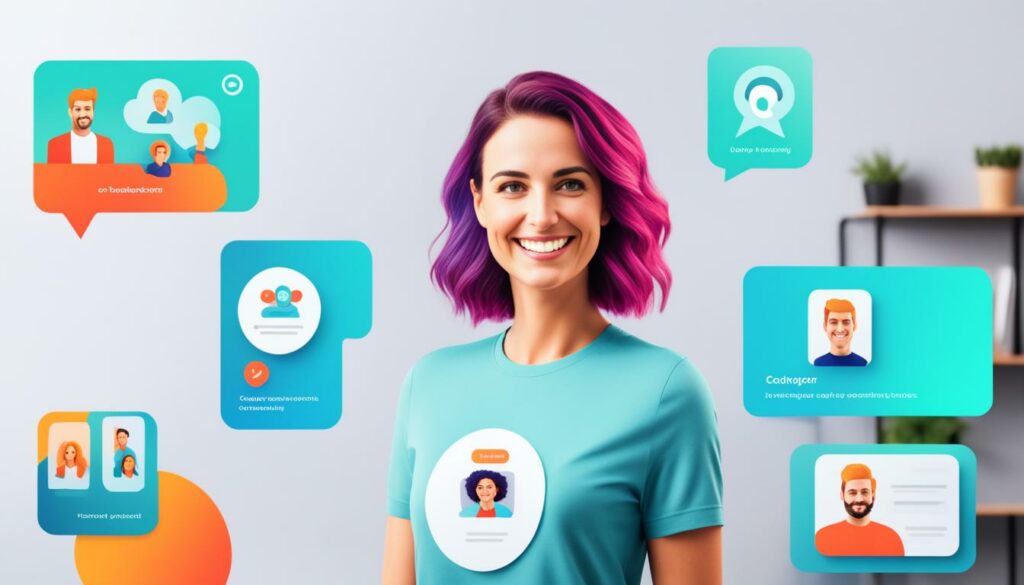Ever thought how tailored prompts could change how we talk to AI? The method of role prompting ChatGPT is changing how we chat with machines. It lets users set specific roles for AI, making answers better. This makes talking to AI more efficient and focused on what you need.
By learning about role prompting, you can make AI work better for you. This changes how we create content and automate tasks, as explained in this detailed article on AI’s effect on making content.
Key Takeaways
- Role prompting makes AI answers better.
- Being specific with prompts leads to better chats.
- ChatGPT can help with many tasks in different areas.
- Customizing prompts makes AI talks more effective.
- Good prompt design cuts down on how long tasks take.
Understanding the Basics of Role Prompting
Role prompting is key to making chatbot interactions better. It helps the AI understand what it should talk about in a certain situation. This makes the chat more useful and clear.
By setting roles, users can shape how ChatGPT talks to them. This leads to better communication that meets their needs. Clear and well-thought-out prompts help get more relevant answers from the AI.
Prompts can be short or long, simple or complex. Using short sentences makes things clearer. This makes it easier for chatbots to understand what to say next, thanks to their training on lots of data.
For good communication, prompts need to be clear, relevant, and well-organized. This affects how well the AI does its job. Things like the tone, who it’s talking to, and what kind of answer is expected matter a lot.
Using special techniques like zero-shot, one-shot, and few-shot prompting can make AI responses better. These methods give the AI more context or examples. This leads to happier users and more engaging chats. Learning from AI chatbot solutions shows how role prompting works in different situations.
Role Prompting ChatGPT: Enhancing Interactions
Role prompting changes how we talk to ChatGPT. By giving the AI a specific role, we get answers that fit our needs better. This makes the AI’s responses more relevant and accurate.
When we tell the AI to be a poet or a personal trainer, it sticks to a certain style. This helps the AI give answers that match the role we want. It makes the AI’s responses more consistent and useful.
How Role Prompting Affects AI Responses
Role prompting makes AI responses better. Instead of just giving general answers, the AI gives responses that match the role we set. For example, asking the AI to be Yoda from “Star Wars” makes the conversation more engaging.
This shows how guiding the AI’s identity can lead to better and more relevant answers. It makes the interaction more meaningful.
Importance of Tailored Prompts for Effective Communication
Creating specific prompts is key to talking effectively with AI. By designing prompts that aim for a certain outcome, we get better answers. The right words and context can greatly improve ChatGPT’s performance.
This is important whether we need information, creativity, or expert advice. Clear and specific prompts help the AI understand what we want. This makes the AI more able to meet our needs.
Developing Effective ChatGPT Prompts
Creating good ChatGPT prompts is key to better AI interactions. By making clear requests for AI, users get more accurate answers. This part talks about how to make prompts clear and why using natural language is important.
Creating Clear and Concise Requests
To get the best from ChatGPT, make your prompts clear and to the point. Good prompts have these traits:
- Specificity: They ask specific questions or tasks.
- Context: They give background info to help the AI understand better.
- Examples: They use examples to show what you want.
For example, instead of asking “Tell me about marketing strategies,” ask,
“As a marketing manager, suggest five innovative digital marketing strategies that can increase engagement for a new product launch.”
This makes the question more specific and gets a better answer.
Utilizing Natural Language to Guide Responses
Using everyday language helps ChatGPT understand what you mean and give better answers. Here’s how:
- Rephrasing: Change your question if the AI doesn’t get it right the first time.
- Specifying roles: Tell the AI what role you are in, like “As a journalist…” or “As a product manager…”, to get answers from that perspective.
- Iterative feedback: Improve your prompts based on what the AI says, making them clearer and more effective over time.
Keep prompts under 500 words to avoid confusing the AI. This field of prompt engineering is growing fast, with experts earning $175,000 to $335,000 a year because they’re so good at making AI work well.
| Prompt Technique | Description | Impact on Response |
|---|---|---|
| Clear Questions | Directly asking precise questions | Increases relevance and accuracy |
| Context Inclusion | Providing background information | Enhances understanding and depth |
| Example Provision | Including samples for reference | Guides style and tone effectively |
| Role Assignment | Stating a specific role for context | Diversifies perspective and insight |
| Iterative Rephrasing | Altering prompts based on previous responses | Improves clarity and engagement |
Using these tips to make better ChatGPT prompts will make your interactions more useful and insightful. It’s a great way to use AI to your advantage.
The Benefits of Using AI Chatbot Prompts
Using AI chatbot prompts brings many benefits for both users and developers. One big plus is how they make interactions better. With structured prompts, users get improved AI interactions. This means chatbots give clearer and more relevant answers.
Another big plus is better accuracy. Tailored prompts help chatbots understand the context better. This leads to answers that match what users are asking. For example, when users share past messages, chatbots can answer follow-up questions well. This keeps conversations flowing naturally.
- Task automation gets a big boost with clear prompts.
- Using specific examples in prompts gives chatbots more information. This makes interactions deeper.
- Improving prompts for generative AI models helps fix any mistakes.
Users can share how chatbot prompts help in real life. Advanced tools for prompting help make FAQ systems and keep conversations on track. This makes the user experience more engaging. Sharing tips on how to improve prompts helps everyone find new ways to use AI better.
It’s also important to encourage critical thinking in users. By guiding chatbot interactions, users can learn to think more deeply. This shows how chatbot prompts can change things in many areas.
Enhancing Conversations with Engaging Chatbot Content
In the world of artificial intelligence, making chatbot content engaging is key to a great user experience. Starting conversations with AI prompts that grab attention is crucial. It encourages users to interact and have deeper talks. ChatGPT, a leading AI, is great at making conversations feel real and works well in many languages. This makes it a top choice for many uses.
Examples of Effective Conversation Starter AI Prompts
Using creative AI prompts can spark creativity and lead to interesting talks. Here are some examples of how well-thought-out prompts can pull users in:
- What are your thoughts on the future of technology?
- Can you share a memorable experience that influenced who you are today?
- If you could travel to any period in history, which would it be and why?
- What hobbies have you discovered that bring you joy?
- How do you envision the ideal workplace for yourself?
Incorporating User Preferences in Prompt Design
Knowing what users like in prompts leads to better chats. Making prompts fit what users enjoy keeps them interested and engaged. Here’s how to do this:
- Gather feedback to learn what users like and dislike.
- Make prompts change based on what users have said before.
- Use data to make the content more personal and effective.

By using these methods, companies can make their chatbots stand out online. As more companies use GPT prompts, making chatbot content more engaging is becoming easier. This is changing how people get information and services.
Leveraging a Prompt Generator Tool for ChatGPT
Using a prompt generator tool can greatly improve ChatGPT prompt creation. It’s essential in fields like Digital Marketing, SEO, and Content Marketing. This tool makes creating prompts fast and easy. It helps marketers, customer service reps, and teachers make custom interactions without hassle.
The tool has a simple interface that users love. Just fill out a form to get lots of custom prompts right away. It offers prompts for Marketing or SEO, making AI prompt optimization easier. This means users get prompts that really fit their needs.
This tool lets users save their prompts for later and gives feedback options. Users can vote on prompts to help improve them. It also lets users suggest new prompts, keeping the tool fresh and innovative.
With this tool, businesses can get more done and be more creative. It helps them stand out in the market. By improving ChatGPT prompt creation and using feedback, this tool shows how custom approaches lead to better AI interactions.
Use Cases for Role Prompting in Various Scenarios
Role prompting has many uses across different areas. It makes things more efficient and innovative, especially in personal help and creative writing. By using specific prompts, personal AI helpers can help with daily tasks. In creative fields, it sparks new ideas and helps organize AI content, making creativity flourish.
Personal Assistance and Daily Task Management
Personal AI uses role prompts to make daily tasks easier. People can use prompts to manage their calendars, set reminders, and organize tasks. This makes them more productive by handling routine tasks automatically. Here are some examples:
- Setting up reminders for upcoming appointments or deadlines.
- Creating a structured daily agenda based on user preferences.
- Generating to-do lists that adapt to changing priorities.
Creative Writing and Content Generation
Role prompting also helps in creative writing and AI content generation. Writers can use prompts to spark ideas and make writing better. This method boosts productivity and brings new viewpoints. Here are some examples:
- Crafting blog posts by providing a specific topic and desired tone.
- Developing scripts or narratives through structured story prompts.
- Generating marketing copy that aligns with brand strategy and target audience.
Role prompting shows its value in many areas. It helps users get more done and be more creative by using personal AI and AI content generation.

Best Practices for Assigning Roles in Conversations
Assigning roles in AI chats makes the conversations better and more relevant. Being clear about the AI’s role can greatly improve how users feel. A clear role helps guide the chatbot, making the talk more engaging and fitting the context.
One good way is to set clear roles that tell the AI what to do. For example, telling ChatGPT to be a historical travel guide means it should share info like a real guide. It’s important to be specific with your requests. A detailed ask leads to better chatbot responses.
Asking the AI to “Act as a science investigator in a lab setting” helps it focus on scientific questions. This makes the chat more relevant and useful.
It’s key to keep updating prompts based on what users say. This feedback helps improve the quality of the chats. For example, teachers use ChatGPT to get ideas for lessons, giving it roles tied to school topics. This not only keeps students engaged but also boosts their critical thinking.
To make chatbot interactions better, try using different role-playing scenarios. Asking ChatGPT about historical figures, literary characters, or scientific topics can make discussions more interesting and informative.
Conclusion
In this journey, we’ve seen how crucial role prompting is for better AI chats. By using specific prompts and knowing how ChatGPT works, users can make their chats more engaging and useful. The summary of AI conversational enhancement shows that AI chatbots like ChatGPT work best with the right prompts from users.
Looking ahead, AI has huge potential in our daily lives and at work. Using smart tips, like giving ChatGPT a name and setting the scene, can solve problems like getting too much info. With half of users having trouble with too much detail, applying what we’ve learned here can make things better.
To sum up, ChatGPT could change how we do many tasks, from writing to legal work. Role prompting helps users get clearer answers and work better with AI. For those wanting to improve their AI skills, checking out custom GPT instructions is a great first step.
FAQ
What is role prompting in ChatGPT?
Role prompting in ChatGPT lets users set specific roles for the AI. This makes the AI’s responses better and more focused, making conversations more efficient.
How does role prompting improve AI interactions?
By setting clear roles and contexts, users get more accurate and relevant answers. This leads to a better and smoother user experience.
What are some of the capabilities of ChatGPT?
ChatGPT is a powerful tool from OpenAI. It can create human-like text for many tasks. This includes answering questions, drafting emails, helping with programming, and creative writing.
How can I create effective prompts for ChatGPT?
Make your prompts clear and to the point. Ask direct questions and provide context. Using natural language helps guide the AI for better interactions.
What are the benefits of using AI chatbot prompts?
Using AI chatbot prompts improves the quality of interactions. It leads to more accurate responses, automates tasks better, and makes dialogue flow smoothly.
What are effective conversation starter AI prompts?
Good conversation starters grab user interest and start meaningful talks. They include user preferences for richer interactions.
How can a prompt generator tool enhance my use of ChatGPT?
A prompt generator tool helps make better prompts. It suggests different structures, keywords, and styles. This makes creating prompts easier and improves chats with ChatGPT.
What are some use cases for role prompting?
Role prompting is great for personal tasks like managing schedules. It also boosts creativity and productivity in writing and content creation.
What are best practices for assigning roles in AI conversations?
Best practices include setting clear roles and being specific with prompts. Keep the conversation context and update prompts based on feedback to improve interactions.




